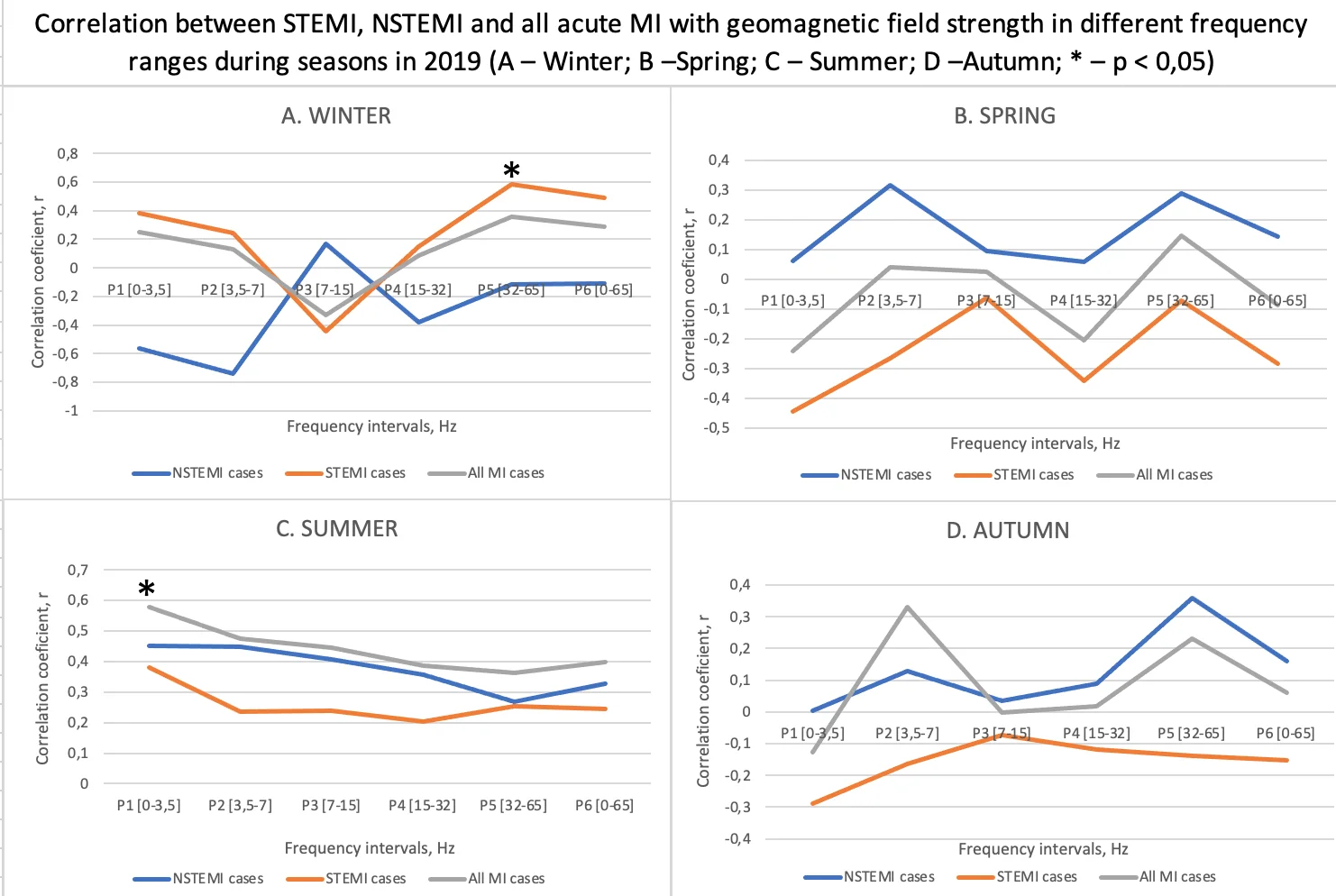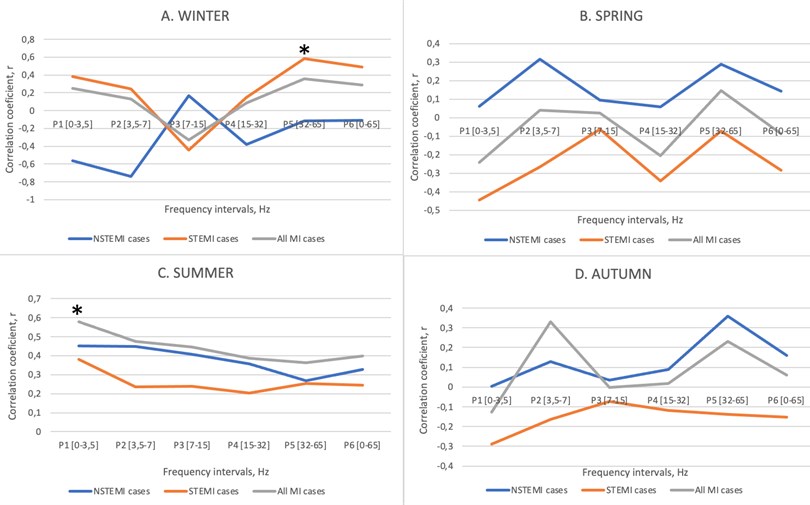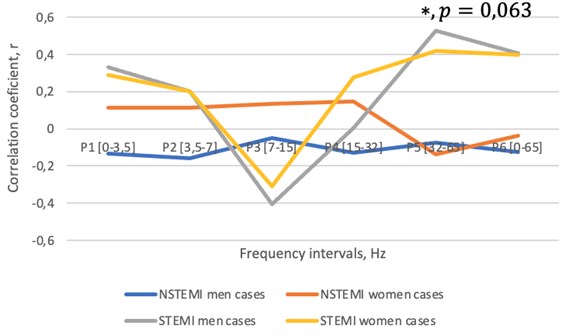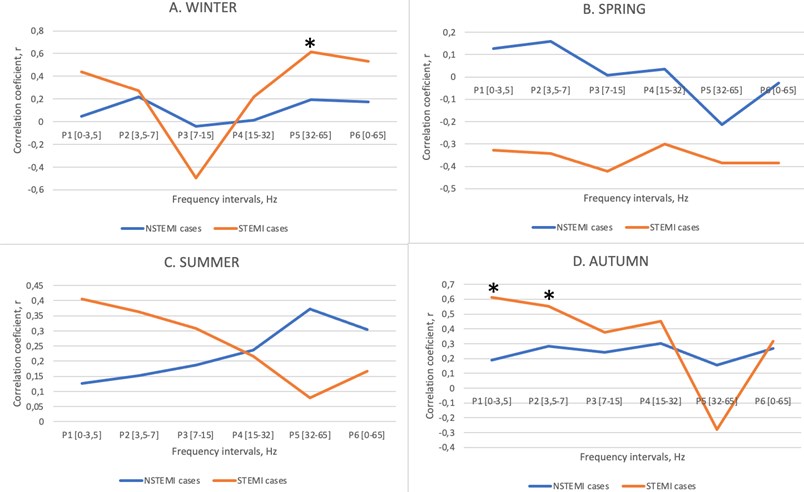Abstract
Stronger oscillations in the local Earth magnetic field may have an impact on the course of ischemic heart disease. This effect is individual for every person and depends on the sex, age, living territory, season, capability to adjust to magnetic field fluctuations and health status. Individuals who already have cardiovascular disease are more sensitive to magnetic field fluctuations, therefore further research is needed to make conclusions. Aim: To identify correlations between changes in local Earth magnetic field frequencies and patients with ST segment elevation myocardial infarction (STEMI) and non-ST segment elevation myocardial infarction (NSTEMI) cases per week, cases by sex per week and patients’ blood laboratory parameters (low-density lipoprotein cholesterol and Troponin I level). Methods: A retrospective study of 1667 patients, who were admitted to the Hospital of Lithuanian University of Health Sciences Kaunas Clinics between 1st January and 31st December 2019 due to acute coronary syndrome (STEMI and NSTEMI), were included in the study. Local Earth's time varying magnetic field (TVMF) was measured by a magnetometer located in Baisogala, Lithuania. Data from the magnetometer was collected daily, and weekly averaged. We assessed the correlations between average weekly geomagnetic field strength in six different frequency ranges (Hz) and average number of STEMI and NSTEMI cases per week, cases by sex per week and patients’ blood laboratory parameters (low-density lipoprotein cholesterol and Troponin I level). Results: The presence of a stronger magnetic field in the frequency range of 32-65 Hz was significantly related to the number of cases in the STEMI group during the winter season ( 0.583, 0.036). Tendency towards a positive correlation was found during the winter in the men's group with STEMI in the high frequency range of 32-65 Hz. Low-density lipoprotein cholesterol level correlated positively in the winter STEMI group with the magnetic field in the 32-65 Hz range, and in the autumn STEMI group with the magnetic field in the frequency range of 0-7 Hz. Conclusion: Increased geomagnetic field strength in the high frequency range of 32-65 Hz is associated with a higher number of cases in the STEMI group.

Highlights
- Increased geomagnetic field activity in high frequency ranges between 32-65 Hz has a positive correlation in the winter season with the STEMI patient group but not in the NSTEMI group.
- LPL cholesterol level correlated positively in the winter STEMI group with the magnetic field activity in the 32-65 Hz frequency range and in the autumn STEMI group in the 0-7 Hz frequency range.
- Our work supports earlier Lithuanian researcher’s studies and confirms that changes in the local geomagnetic field high Schumann frequency (SGamma) range are correlated with a higher number of STEMI cases.
1. Introduction
Cardiovascular diseases (CVD) are one of the leading causes of death in the world, claiming more lives each year than cancer and lung disease combined [1]. There are known, preventable risk factors contributing to the progression of ischemic heart disease such as dyslipidemia, arterial hypertension, metabolic disorders such as diabetes mellitus and thyroid diseases, smoking, heavy alcohol consumption, stress, low physical activity, and obesity [1]. Nevertheless, morbidity and mortality from CVD remain high. It is hypothesized that environmental factors such as the local Earth’s magnetic field activity may also be significant in the development of CVD [11, 12]. Disruption of the local Earth’s magnetic field causes severe adaptive stress at all levels of body regulation [7, 9, 10]. In a healthy population, disturbances in the local Earth’s magnetic field has been shown to reduce heart rate variability and blood flow, as well as to increase platelet aggregation and coagulation [7, 9, 10]. The effects are much more pronounced in patients with CVD and other risk factors [7, 9]. A stronger association between arrhythmias, such as acute atrial fibrillation, and fluctuations in local magnetic field activity has been found in groups of individuals with arterial hypertension [4]. Studies show that the intensity of the magnetic field at different frequencies affects the body differently: in the low frequency range it has a positive effect on human health, while in the higher frequency range it is associated with increases in health disorders [2-4]. Nevertheless, the results remain rather contradictory and more detailed studies are needed to draw general conclusions.
2. Literature review
Changes in the Earth's magnetic field affect the regulatory mechanisms of the cardiovascular system [5]. A study published in 2004 states that the enhancement of the geomagnetic field affects baroreceptors, leading to changes in heart rate and arterial blood pressure variability [6]. The article states that geomagnetic storms have been shown to increase the arterial blood pressure and oxygen demand of the heart, thus increasing the risk of cardiovascular events, and worsening the outcomes after a previous myocardial infarction (MI) [6]. Another study found that the effects of geomagnetic storms in individuals with comorbidities such as diabetes mellitus, hypertension or overweight are stronger than in the healthy population [7]. It affects heart rate variability, increased blood viscosity, coagulation, and platelet aggregation [7]. In an artificially simulated magnetic field experiment with laboratory mice, the difference in myocardial ischemia-reperfusion injury was observed depending on different magnetic field conditions [8]. The study revealed that myocardial ischemia-reperfusion injury was greater in mice exposed to an artificial geomagnetic field than in those isolated from the magnetic field [8].
Recently, more attention is being paid not only to the changes in the global magnetic field, but also to the changes in the local Earth's time varying magnetic field (TVMF) and their influence on the body's intracellular processes. Currently, there are 6 calibrated, time synchronized magnetometers in the world that record local geomagnetic fields and changes in their strength. According to the data of the magnetometer in Lithuania, it can be seen that the local strength of the TVMF (resonant frequencies) is constantly changing, and these changes are characterized by seasonal variations: the highest intensity is observed in late summer and the lowest in winter [2]. It has been found that changes in the human body are caused by alterations in the intensity of certain frequencies rather than the absolute strength of the geomagnetic field. Changes in the low frequency range have a positive effect on the body, while high frequency changes promote pathological changes [3]. However, it has been observed that the amplification of a low-frequency geomagnetic field has a positive effect on the body's changes in acute ischemic syndromes but can also lead to disturbances in heart rhythm and conduction [2-4].
3. Methods
A retrospective study of 1667 patients, who were admitted to the Hospital of Lithuanian University of Health Sciences Kaunas Clinics between 1st January and 31st December 2019 due to acute coronary syndrome (STEMI and NSTEMI), were included in the study. Local Earth’s time varying magnetic field was measured by a magnetometer located in Baisogala, Lithuania. Data from the magnetometer was collected daily, and weekly averaged. Aim of the study was to assess the correlations between the average weekly geomagnetic field strength in six different Schumann frequency ranges (Hz): P1 (SDelta) [0-3.5]; P2 (STheta) [3.5-7.0]; P3 (SAlpha) [7.0-15.0]; P4 (SBeta) [15.0-32.0]; P5 (SGamma) [32.0- 65.0]; P6 [0-65.0] and the average number of STEMI and NSTEMI cases per week, cases by sex per week and patients’ blood laboratory parameters (low-density lipoprotein cholesterol and Troponin I level). The TVMF intensity was recorded North - South and East - West directions. We analyzed the East - West direction as the Heart Math Institute found it has a more potent effect on human health. Magnetometer’s data was processed with an acquisition system (Symmetric Research, Las Vegas, NV, USA) at a rate of 130 Hz. Study period was divided into 4 seasons: Winter (December - February), Spring (March - May), Summer (June - August), Autumn (September - November). Microsoft Excel and IBM SPSS Statistics version 27.0 were used for analysis. The Kolmogorov-Smirnov test showed that data was normally distributed. Data was analyzed using descriptive statistics and Pearson correlation coefficient (). The relationship between the two quantitative features was considered weak if the correlation coefficient () was up to 0.3, moderate- between 0.3 and 0.75, and strong if it was greater than 0.75. value < 0.05 was considered statistically significant.
4. Results
The population according to sex is presented in Table 1. Blood laboratory indicators’ (LDL and cTnI) distribution in STEMI and NSTEMI groups is shown in Table 2.
Table 1The population according to sex
Indication | Men | Women | All patients |
Count of patients | 1073 (64,37 %) | 594 (35,63 %) | 1667 (100 %) |
Age | 65,2 (SD=12,22) | 74,01 (SD = 11,01) | 68,34 |
NSTEMI group | 591 (62,8 %) | 350 (37,2 %) | 941 out of 1667 (56,45 %) |
STEMI group | 482 (66,39 %) | 244 (33,61 %) | 726 out of 1667 (43,55 %) |
Table 2LDL and cTnI distribution in STEMI and NSTEMI groups
Indication | NSTEMI group | STEMI group | All patients |
Count of cTnI | 904 (56,61 %) | 693 (43,39 %) | 1597 (100 %) |
Average of cTnI(mcg/l) | 5,06 (SD = 1,14) | 24,24 (SD = 1,45) | 19,06 |
Count of LDL | 824 (55,98 %) | 648 (44,02 %) | 1472 (100 %) |
Average of LDL (mmol/l) | 3,33 (SD = 1,45) | 3,49 (SD = 1,45) | 3,42 |
Analyzing the data of 2019, it was observed that the presence of a stronger magnetic field in the frequency range between 32-65 Hz correlated significantly with the count of STEMI patients during the winter season ( 0.583, 0.036), while in the NSTEMI group no reliable correlations were found (–0.116, 0.706) (Fig. 1).
There were no significant geomagnetic field strength changes in other frequency ranges (0-3.5 Hz; 3.5-7.0 Hz; 7.0-15.0 Hz; 15.0-32.0 Hz; 0-65.0 Hz) during the winter season. No reliable correlations were found in geomagnetic field changes in the spring, summer, and autumn season groups. In the data of 2019 we observed a non-significant trend in the differences between sexes: there was a stronger positive correlation in men’s STEMI group compared with female’s group during the winter season ( 0.533, 0.063), (Fig. 2).
There were no significant correlations between cardiac troponin I (cTnI) and geomagnetic field strength during all seasons. Low-density lipoprotein cholesterol level correlated positively in the winter STEMI group with magnetic field in the frequency range of 32-65 Hz ( 0,615, 0,025) and in the autumn STEMI group with magnetic field in the frequency range 0-3.5 Hz ( 0,611, 0,026) and 3.5-7 Hz (0,554, 0,049) (Fig. 3).
Fig. 1Correlation between STEMI, NSTEMI and all acute MI with geomagnetic field strength in different frequency ranges during seasons in 2019 (A – Winter; B – Spring; C – Summer; D – Autumn; * – p< 0.05)

Fig. 2Correlation between men and female in STEMI and NSTEMI groups with geomagnetic field strength in different frequency ranges during Winter in 2019

5. Discussion
The association of geomagnetic field fluctuations with acute ischemic syndrome has been repeatedly shown. However, research into the effects of the various frequencies in the local Earth’s magnetic field is just beginning. Articles published in 2018 state that the relationship between local Earth's time varying magnetic field and the frequency of unstable angina and STEMI cases is statistically significant [2-4]. The incidence of unstable angina and STEMI, higher concentrations of troponin I (TnI) and greater coronary artery damage were more frequent in the presence of a more intense high-frequency 32 - 65 Hz local Earth’s magnetic field range [2, 3]. It has also been found that coronary arteries are protected in the presence of lower frequencies than by a stronger high-frequency local Earth’s magnetic field [2, 3]. In our study, a significant correlation was found between the number of STEMI cases with the high frequency 32-65 Hz local Earth’s magnetic field range. However, there was no significant correlation with NSTEMI. In addition, a positive correlation between changes in acute coronary syndrome and local Earth’s magnetic field intensity in the high frequency range 32-65 Hz in the male group during the winter season was observed, whereas in previous studies, it was observed in the female group [2, 3]. No significant association of TnI with magnetic fields was observed in this study, as reported in previous studies [3]. This may be due to the fact that the magnitude of TnI depends on the onset of symptoms and the timing of blood sampling, which varies between cases. It is therefore very difficult to draw general conclusions as many of the individual characteristics that lead to different relationships with the surrounding environment are unknown.
Fig. 3Correlation between LDL in STEMI and NSTEMI groups with geomagnetic field strength in different frequency ranges during seasons in 2019 (A – Winter; B – Spring; C – Summer; D – Autumn; * – p< 0.05)

6. Conclusions
Increased geomagnetic field activity in high frequency ranges between 32-65 Hz has a positive correlation in the winter season with the STEMI patient group but not in the NSTEMI group. There was a tendency of stronger positive correlation in men's STEMI group during the winter season with activity in the high frequency range of 32-65 Hz compared with female’s STEMI group. LPL cholesterol level correlated positively in the winter STEMI group with the magnetic field activity in the 32-65 Hz frequency range and in the autumn STEMI group in the 0-7 Hz frequency range. Our work supports earlier Lithuanian researcher’s studies and confirms that changes in the local geomagnetic field high Schumann frequency (SGamma) range are correlated with a higher number of STEMI cases.
References
-
E. J. Benjamin et al., “Heart disease and stroke statistics-2019 update: a report from the american heart association,” Circulation, Vol. 139, No. 10, Mar. 2019, https://doi.org/10.1161/cir.0000000000000659
-
G. Jaruševičius, T. Rugelis, R. Mccraty, M. Landauskas, K. Berškienė, and A. Vainoras, “Correlation between changes in local earth’s magnetic field and cases of acute myocardial infarction,” International Journal of Environmental Research and Public Health, Vol. 15, No. 3, p. 399, Feb. 2018, https://doi.org/10.3390/ijerph15030399
-
G. Žiubrytė, G. Jaruševičius, M. Landauskas, R. Mccraty, and A. Vainoras, “The local earth magnetic field changes impact on weekly hospitalization due to unstable angina pectoris,” Journal of Complexity in Health Sciences, Vol. 1, No. 1, pp. 16–25, Jun. 2018, https://doi.org/10.21595/chs.2018.20020
-
G. Žiubrytė, G. Jaruševičius, J. Jurjonaitė, M. Landauskas, R. Mccraty, and A. Vainoras, “Correlations between acute atrial fibrillation and local earth magnetic field strength,” Journal of Complexity in Health Sciences, Vol. 1, No. 2, pp. 31–41, Dec. 2018, https://doi.org/10.21595/chs.2018.20430
-
V. A. Ozheredov et al., “Influence of geomagnetic activity and earth weather changes on heart rate and blood pressure in young and healthy population,” International Journal of Biometeorology, Vol. 61, No. 5, pp. 921–929, May 2017, https://doi.org/10.1007/s00484-016-1272-2
-
J. Gmitrov and A. Gmitrova, “Geomagnetic field effect on cardiovascular regulation,” Bioelectromagnetics, Vol. 25, No. 2, pp. 92–101, Feb. 2004, https://doi.org/10.1002/bem.10173
-
J. Vencloviene, R. M. Babarskiene, and D. Kiznys, “A possible association between space weather conditions and the risk of acute coronary syndrome in patients with diabetes and the metabolic syndrome,” International Journal of Biometeorology, Vol. 61, No. 1, pp. 159–167, Jan. 2017, https://doi.org/10.1007/s00484-016-1200-5
-
H. Wu et al., “Effect of simulated geomagnetic activity on myocardial ischemia/reperfusion injury in rats,” Brazilian Journal of Cardiovascular Surgery, Vol. 34, No. 6, p. 674, 2019, https://doi.org/10.21470/1678-9741-2018-0306
-
Abdullah Alabdulgade et al., “Human heart rhythm sensitivity to earth local magnetic field fluctuations,” Journal of Vibroengineering, Vol. 17, No. 6, pp. 3271–3278, 2015.
-
A. Alabdulgader et al., “Long-Term Study of Heart Rate Variability Responses to Changes in the Solar and Geomagnetic Environment,” Scientific Reports, Vol. 8, No. 1, Dec. 2018, https://doi.org/10.1038/s41598-018-20932-x
-
Y. I. Gurfinkel, O. Y. At’Kov, A. L. Vasin, T. K. Breus, M. L. Sasonko, and R. Y. Pishchalnikov, “Effect of zero magnetic field on cardiovascular system and microcirculation,” Life Sciences in Space Research, Vol. 8, pp. 1–7, Feb. 2016, https://doi.org/10.1016/j.lssr.2015.11.001
-
V. A. Ozheredov, T. K. Breus, Y. I. Gurfinkel, B. A. Revich, and T. A. Mitrofanova, “Influence of some weather factors and geomagnetic activity on the development of severe cardiological pathologies,” Biophysics, Vol. 55, No. 1, pp. 110–119, Feb. 2010, https://doi.org/10.1134/s0006350910010185

